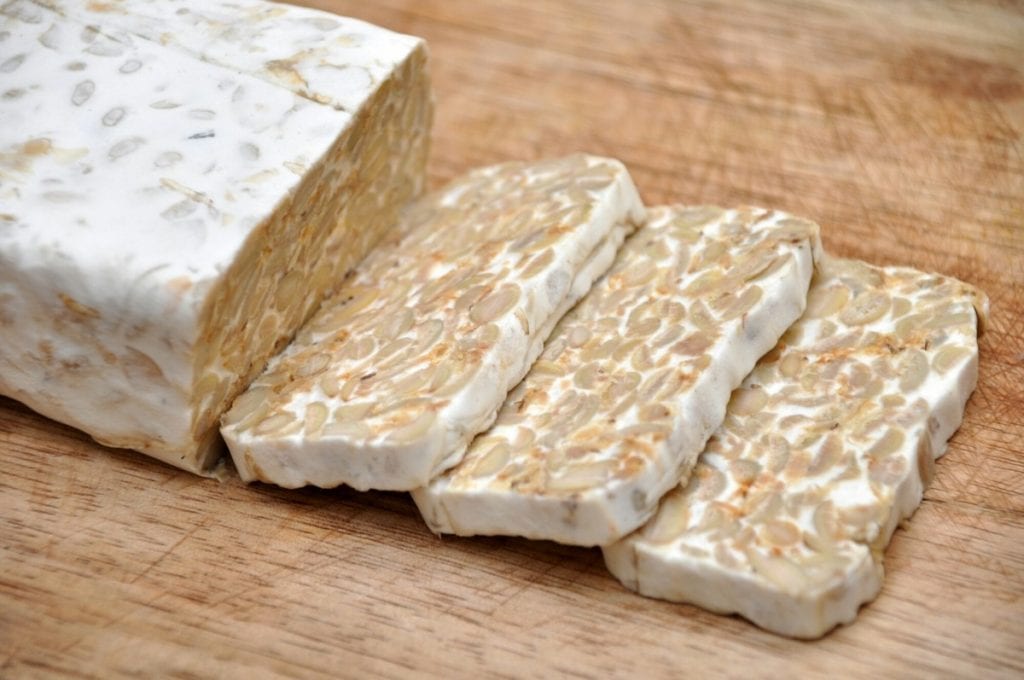A firm and compact block of fermented soy, to be sliced and enjoyed grilled, fried, baked in the oven, accompanied with vegetables or seasoned with gravies and sauces: tempeh is considered the "meat of vegans", a food with a characteristic flavour that is much appreciated by those who follow a vegetable diet. It is rich in nutrients and very digestible. As always, we are not talking about necessary products: legumes, cereals, fruit and vegetables are enough for a balanced diet, but having easy, quick to prepare and tasty products available can still come in handy. Here's everything you need to know about tempeh.

Tempeh: what it is and how was it born
First, a little history. Tempeh was born in Indonesia, on the island of Java, and quickly spread to most of the countries of South-East Asia starting in the Sixteenth century, when it was one of the main sources of protein. It was the Dutch who brought it to Europe but, as with all typically vegan products such as tofu and seitan, we have to wait until the 80s, when it began to take hold, thanks to the spread of a healthy culture and the increase of people who choose to follow a vegetarian diet. It was also cited by the American Journal of Clinical Nutrition as the perfect low-cost meat substitute. To prepare it, peeled soybeans are soaked, then partially cooked and fermented thanks to a particular spore. At the end of the process, the seeds are compacted to form white blocks, with the soybeans clearly visible on the surface. Unlike tofu, which is excellent marinated and cooked, tempeh has a more intense flavour, somewhat reminiscent of mushrooms (or, according to many, of walnuts).
Characteristics and properties of tempeh
With a little patience, tempeh can also be prepared at home with yellow soybeans, water, apple cider vinegar and a starter of Rhizopus oryzae or Rhizopus oligosporus, which can be purchased in stores specialising in natural foods or online. It can be stored in the refrigerator for up to 5 days or frozen in the freezer: if you choose the first option, it is advisable to vacuum-pack it, so as to keep it even longer and preserve all its characteristics. As far as nutritional properties: it is a food rich in magnesium, phosphorus and calcium and, like all fermented products, it is easily digestible because it is rapidly absorbed. The glycemic index is low, the protein content instead very high: it is also a precious source of vitamins B2 and fibre. It can be found in most well-stocked supermarkets, in the refrigerated counter, or in specialised shops, even in other variants made with chickpeas, peas or lentils: try them all and choose your favourite.

How to use tempeh in the kitchen
There are many recipes employing tempeh. For simple, fast and foolproof use, just grill it and accompany it with vegetables: no special marinades are required, a little extra virgin olive oil, salt and pepper will suffice. But then you can indulge in many other ways. Try it glazed with a mix of olive oil, mustard and maple syrup (or agave, or any alternative sweetener to honey of your choice) and serve it with basmati rice with a squeeze of lemon and some fresh coriander. Otherwise, you can chop it to pieces, flour it and cook it in a pan with a little olive oil and some champignon mushrooms to accentuate its characteristic flavour (add a little vegetable drink or coconut milk to make the dish creamier). For a delicious complete meal dish, stew some leek in a pan, add sliced tempeh, almonds, soy sauce and ginger, then accompany the dish with rice and vegetables of your choice. If you have guests for dinner, you can prepare it in the oven, marinated with barbecue sauce, or make skewers alternating with seasonal vegetables, baked in the oven and then seasoned with teriyaki sauce.
Recipe for tempeh and lettuce salad with yoghourt dressing
A hearty and delicious dish, a kind of Caesar salad (very revisited), also perfect to take to the office for your lunch break. If you plan on eating it the next day, remember to add the sauce only at the end.
Ingredients
300 g lettuce
300 g tempeh
200 g bread
200 ml vegan yoghourt
2 Tbsp. lemon juice
1 Tbsp. mustard
1 tsp brined capers
Extra virgin olive oil
Salt
Start with the sauce: pour vegan yoghurt into a blender together with lemon juice, mustard, capers and 1 tablespoon of extra virgin olive oil. Blend and keep aside. Slice tempeh and cook it in a pan with a drizzle of extra virgin olive oil and a pinch of salt for about 5 minutes over high heat. Cube the bread (you can also use stale bread, after having softened it with a little water) and toast it in a pan for a few minutes. Clean and cut the lettuce and place it in a bowl. Add the tempeh, croutons and dress with the sauce. If you want, you can enrich the salad with nutritional yeast to recreate the flavor of Parmigiano cheese (it is a vegetable flavour enhancer).
by Michela Becchi


 Three days at Lake Como in 17 destinations: Trattorias, Osterias and Fine Dining
Three days at Lake Como in 17 destinations: Trattorias, Osterias and Fine Dining Piedmontese classics and raw seafood. The unexpected restaurant with a pool in the Langhe
Piedmontese classics and raw seafood. The unexpected restaurant with a pool in the Langhe US Tariffs. according to the Government, a 10% rate would not be impactful, but for most wineries the risk is high
US Tariffs. according to the Government, a 10% rate would not be impactful, but for most wineries the risk is high Grilled vegetables and chicken on the side: in Chianti, plant-based cuisine takes centre stage
Grilled vegetables and chicken on the side: in Chianti, plant-based cuisine takes centre stage A top gelato maker from Florence launches flavours dedicated to women who made history
A top gelato maker from Florence launches flavours dedicated to women who made history






